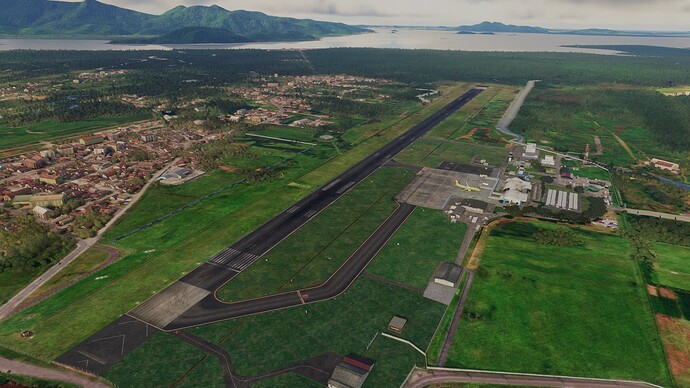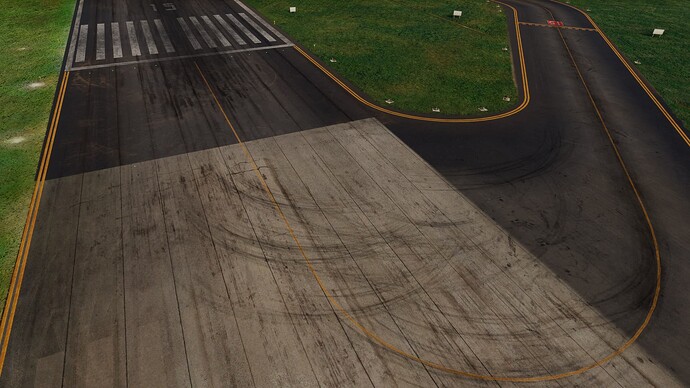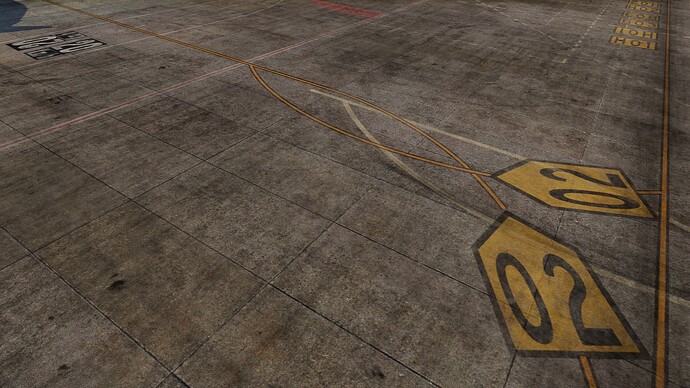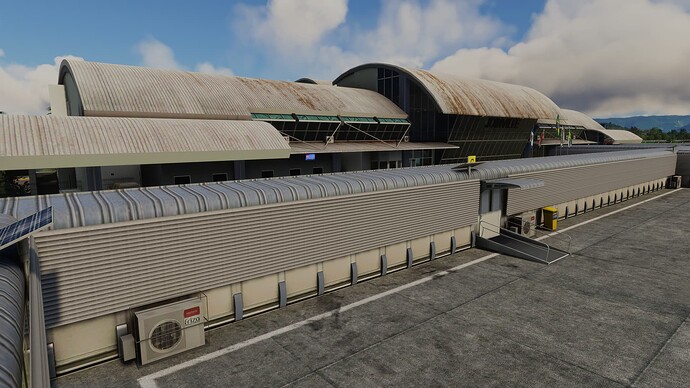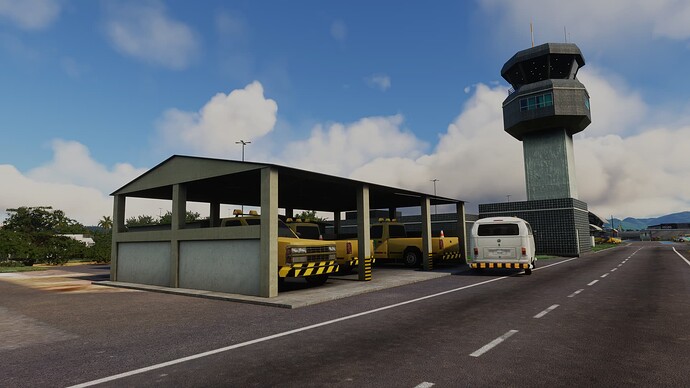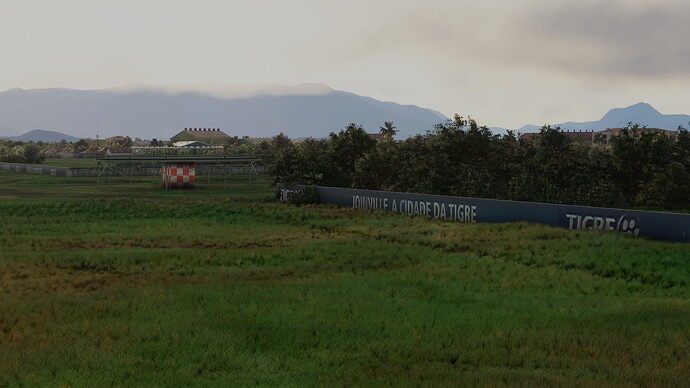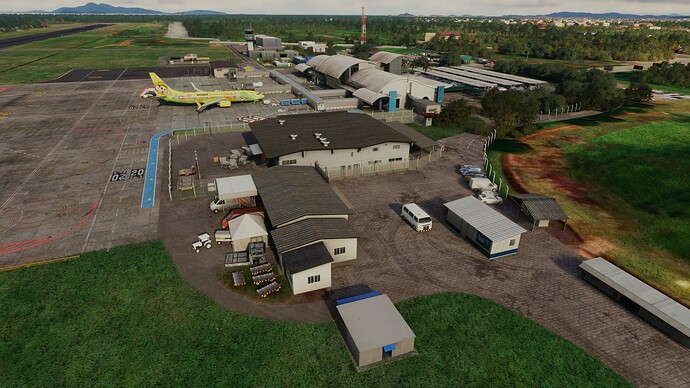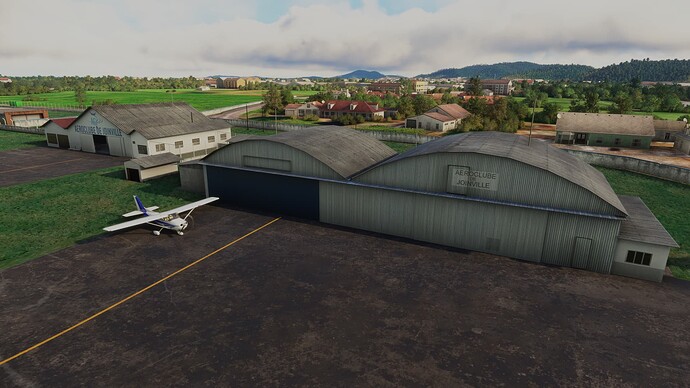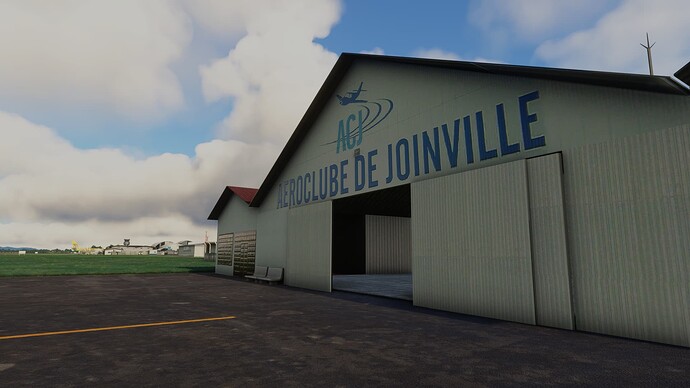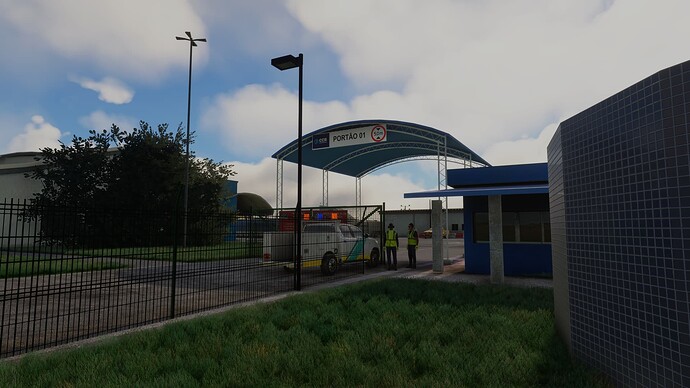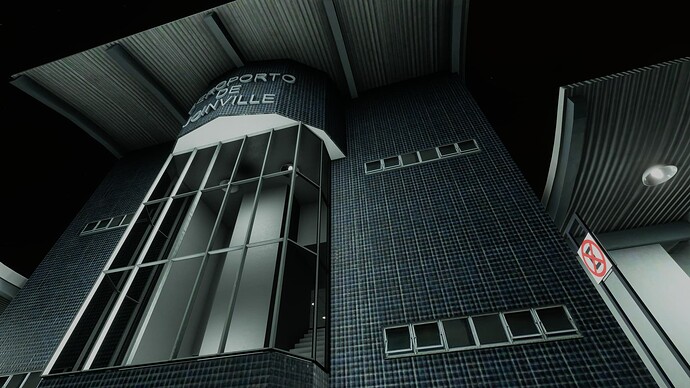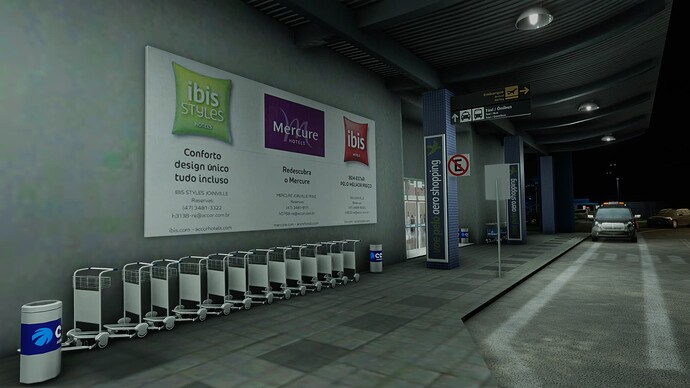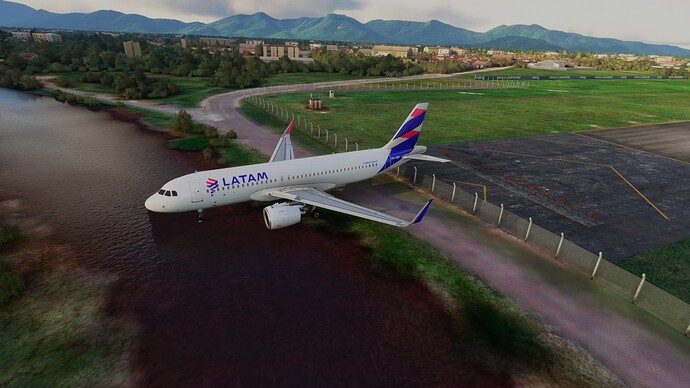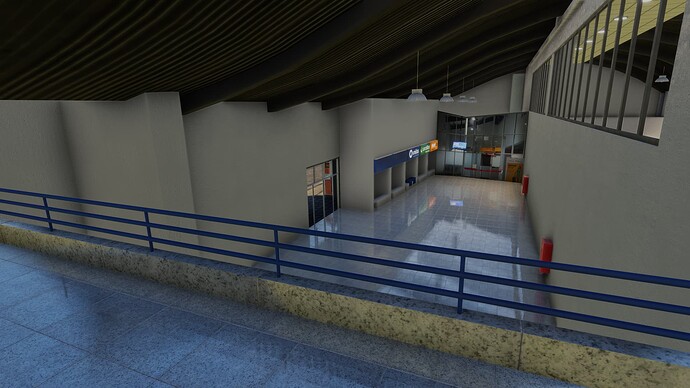Test machine specs: MSI X670E, AMD Ryzen 7 7800X3D, AMD Radeon RX 7900XTX, 48gb RAM
Add-ons: FSLTL, GSX Pro, REX AccuSeason (which may misrepresent some colours in certain light conditions)
DETAIL
I’ve always enjoyed Paulo’s airports: while their textures may not be of the highest resolution (in fact, by 2025’s standards, they’re pretty low-res), they’re always photo-realistic and exhibit some very convincing weathering/wear-and-tear. I was, however, lukewarm towards his last project (Porto Seguro) as it appeared rushed and somewhat unfinished. Sadly, Joinville is very similar in this regard. Don’t get me wrong: in some areas, it’s typical Paulo Ricardo quality — there are just some sloppy flaws and omissions that take the shine off what could be a very good scenery.
As with all Paulo’s airports, the terminal and its immediate surroundings look fantastic… with the caveat that you don’t get too close! Some of the textures are quite high-res (those on the unique jetways, for example) but the majority are below the last couple of years’ average. Unlike the majority of devs, there’s no obvious reasoning behind the placement of these low-res textures, with them cropping up in both heavily-traversed AND far more secluded corners of the airfield. Ordinarily, of course, you expect a drop in resolution as you move into a scenery’s peripheral areas but it’s all a bit of a lottery here.
The terminal features a partial interior. It’s okay but nothing to write home about: there are a handful of animated passengers wandering around (countable on one hand, and of the variety that vanish and repeat their ‘algorithm’ all over again), some seating and a few bits of eye-candy adorning the walls. Other than that, it feels quite empty, with many windows and transparent doors featuring simple 2D texturing to represent what’s behind them.
The terminal’s outdoor landside is mostly custom and is a fairly strong area of the scenery (in spite of the abundance of default Asobo cars that far outnumber the handful of boxy custom models). Again, the textures aren’t of great resolution but they look superb from distance. There’s a fair amount of clutter, including custom vegetation, but a couple of trees have oddly been hand-placed right in the middle of one of the terminal’s entry/exit roads.
Moving onto the scenery’s stronger points… the apron, taxiways and runway look amazing: high-res textures, excellent weathering effects and some of the best ground markings I’ve ever seen. It really is in stark contrast to almost everything else. There’s not too much ramp clutter but what there is is a decent mix of default and custom assets (including a good number of Asobo’s animated ground workers).
Another strong point is the airport’s night-lighting, which really brings the photoreal textures to life after dark. Most of the runway/taxiway lights are emissive (for those unfamiliar, they cast ambient light onto the ground in their immediate vicinity) and the main apron floodlighting features those nice bloom effects we’ve become accustomed to lately. In spite of the terminal’s lacklustre interior, it offers enough to really shine (pardon the pun) at night.
Unusually (and to our chagrin), Paulo has decided not to model anything in the vicinity of the airport, so the juxtaposition with default surroundings is slightly awkward.
PERFORMANCE
Paulo Ricardo’s airports are always comparatively small files but imagine my surprise when this one downloaded at under 300mb! It could be argued that the reduced texture size is what makes Paulo’s airports run so well but, unlike Santos Dumont and Congonhas, Joinville shouldn’t need too much optimisation as it’s a small regional airport, away from any heavy PG areas. Performance is so good that I think those textures could easily be of a higher quality, without having too much negative impact. I’ve no idea if the inherent nature of photoreal textures (irrespective of resolution) makes them more resource-hungry but the likes of Marcus Nyberg, Flightbeam and Flyt Sims have all recently managed great performance with similar but higher-res textures.
VERDICT
Paulo’s last two airports have arguably been inferior to his earlier releases. Campinas has one of the best interiors (certainly for its time), and Santos Dumont and Congonhas perform well, despite being in extremely dense urban settings. There doesn’t seem a logical reason to me to tone down the detail for later, more isolated airports that can take advantage of a continuously-evolving SDK.
Does this mean SBJV is a bad scenery? Not at all but it’s definitely not up to the dev’s usual standard. It surely wouldn’t have taken much to model a better terminal interior, or to make sure custom trees don’t block roads? Or to ensure the perimeter fence doesn’t contain gaps? But these issues are immaterial compared to FSLTL compatibility, which sees aircraft taxi THROUGH the fence and into an adjacent neighbourhood for take-off! The aircraft I observed was halfway to Rio and still on the ground when I gave up tracking it! There are other issues, too: floating walls, and buildings sitting in water to the south of the terminal (there’s a large canal in this area) — but, giving the benefit of the doubt to Paulo, these could be attributed to Asobo.
Sadly, the little flaws and omissions mount up to the point that the well-done parts aren’t really able to save this scenery. Photoreal textures and excellent night-lighting do little to mitigate the immersion-killing experience of watching FSLTL airliners taxiing all over the grass and into housing estates. Many of the low-res textures are in places that make them too noticeable, and the lack of an included GSX profile means that marshallers are on rooftops and ground equipment is stuck in walls and buildings.
On the positive side, there is often only one airliner on the deck at any one time so the chances of actually seeing the AI traffic spectacle are pretty low (it might even be insignificant for some). Furthermore, it shouldn’t be long before someone offers a GSX profile so the GSE problem will hopefully not persist.
It’s a shame the airport suffers from so many little flaws. The low-res textures I could easily live with if everything else was fine but in SBJV’s case, they just serve to compound other, more serious problems. If Paulo can revisit the airport and work on some fixes, this will be a decent airport. But as it is — and with no detail around the perimeter — it’s a bit of a disappointment (particularly when you consider what this guy is capable of).
However, one final point is that Joinville has a lower price than all Paulo’s previous airports, which could possibly reflect the seemingly more rushed, less detailed approach?
In conclusion, this is a decent airport if you a) aren’t fussed about seeing AI traffic do things by the book; b) aren’t bothered about terminal interiors; or c) prefer flying at night. The missing bits of perimeter fence and the swimming structures aren’t really going to be noticed while taxiing, taking off or landing, such are their locations. But this is a story about what COULD’VE been, because Paulo has an enviable record of producing quality Brazilian airports. I’d rather pay a couple of pounds more and have full service resumed…
Ground textures: 10/10
Building textures: 8/10
Apron clutter: 7/10
Terminal interior: 4/10
Outdoor landside detail: 7/10
Jetway connection: 10/10
Performance: 10/10
FSLTL compatibility: 1/10
GSX compatibility: 4/10
Night-lighting: 10/10
Overall immersion: 6/10
IMAGES
